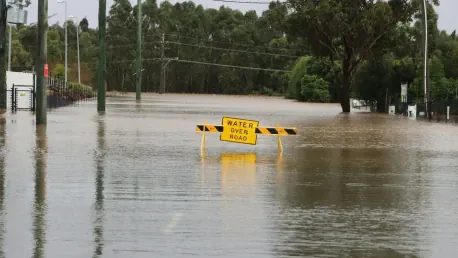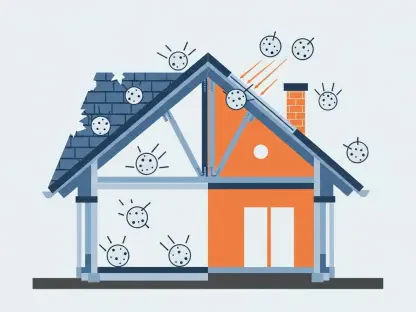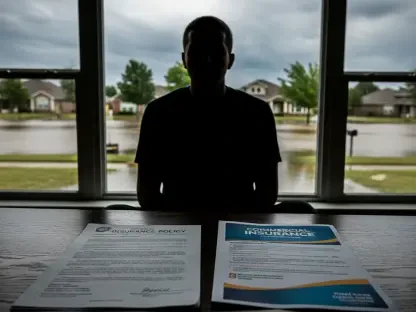The United States faces a growing challenge in securing affordable flood insurance as severe weather events become more frequent due to climate change. Flooding no longer threatens only coastal areas but increasingly impacts urban and inland regions. The result is a widening insurance protection gap fueled by outdated regulatory frameworks, economic pressures, and evolving risk assessments. Comprehensive action, involving both innovative solutions and policy updates, is essential to close this gap and safeguard communities across the country.
The Escalating Impact of Climate Change on Flood Risks
Broadening Scope of Flood Risk Areas
Climate change is dramatically altering flood risk landscapes across the United States, expanding the list of vulnerable areas far beyond the traditional coastal zones. Storms like Hurricanes Ida, Beryl, and Debby have demonstrated that heavy, unexpected rainfall can cause extensive damage even in places previously considered safe from flooding. As a consequence, inland and urban areas now face flood threats that were once the exclusive concern of coastal communities, necessitating a reevaluation of preparedness and resilience strategies.
The broadening scope of flood risk underscores the inadequacy of existing measures and calls for a swift response to prevent catastrophic losses. Urban planning must adapt to these new realities, integrating flood resilience into infrastructure development to protect both property and human lives. As climate change continues to alter weather patterns unpredictably, it’s critical that flood risk management strategies evolve to cover all potentially impacted regions. This shift not only protects individual properties but also contributes to the overall economic stability of affected areas.
Economic Toll of Flooding on a National Scale
Flooding’s economic toll on the US is substantial and far-reaching, with estimated costs from the Senate Joint Economic Committee ranging between $180 billion and $496 billion annually. These figures capture both the immediate physical damage inflicted by floodwaters and the prolonged disruptions to business activities that follow, painting a grim picture of the financial burden flooding imposes. Businesses unable to resume operations quickly may face insolvency, thereby contributing to job losses and economic downturns in affected areas.
This staggering economic impact underscores the need for effective flood insurance coverage to mitigate financial risks and ensure quicker recovery. Without adequate insurance, communities face the daunting prospect of rebuilding with limited financial resources, further exacerbating economic disparities. Robust insurance policies must be complemented by government interventions and private sector involvement to create a framework that supports rapid recovery and long-term resilience against future flood events.
Challenges Facing the Insurance Market
National Flood Insurance Program (NFIP) Debt Crisis
The National Flood Insurance Program (NFIP) is currently grappling with an escalating debt crisis, with liabilities exceeding $20.5 billion. This financial strain severely undermines the program’s capacity to provide sustainable and affordable insurance options, particularly for homeowners in high-risk areas. The NFIP’s financial woes are compounded by outdated risk assessment models and inadequate funding, making it increasingly difficult to cover claims without further indebting the program.
Efforts to overhaul the NFIP, including the introduction of the Risk Rating 2.0 pricing model in 2023, aim to align premiums more closely with individual property risks. While this reform seeks to rationalize risk management, it has inadvertently led to steep premium hikes, putting flood insurance out of reach for many low-income homeowners. These escalated costs highlight the urgent need for comprehensive policy reforms that balance risk-based pricing with affordability to prevent a surge in uninsured or underinsured properties.
Private Insurers’ Market Withdrawal
The private insurance sector is also facing significant challenges, with many insurers opting to increase premiums or withdraw from high-risk markets altogether. States such as Florida and California have seen a notable retreat of private insurers, leaving a void that exacerbates the insurance protection gap. High-risk areas, already vulnerable to frequent and severe flooding, now find themselves with limited insurance options, pushing homeowners to either accept financially crippling premiums or forego coverage entirely.
This market withdrawal is driven by the rising costs associated with frequent flood claims, which strain insurers’ financial viability. The insurance industry’s retreat from these regions underscores the necessity of establishing innovative models that can provide affordable coverage while managing financial risks effectively. Regulatory support and public-private partnerships are essential to incentivize insurers’ continued presence in these high-risk markets, ensuring that homeowners are not left unprotected in the face of increasingly severe flood threats.
Regulatory and Data Deficiencies
Outdated FEMA Flood Maps
Outdated FEMA flood maps pose a critical barrier to the accurate assessment and pricing of flood risks. Many of these maps have not been updated for decades, failing to reflect contemporary climate data or urbanization trends. As a result, both insurers and property owners lack reliable information to evaluate flood risks appropriately, leading to mispriced insurance policies and unexpected financial losses. Accurate maps are fundamental to understanding and mitigating flood risks effectively.
To bridge this gap, FEMA must prioritize regular updates to its flood maps, incorporating real-time climate data and the latest geographic changes. Improved mapping will enable more precise risk assessments, benefiting insurers in pricing policies accurately and homeowners in understanding their exposure to flood hazards. These updated maps must consider the effects of climate change, including increased rainfall and changing weather patterns, to provide a holistic view of flood risks in different regions.
Gaps in Data Collection and Integration
The shortcomings in data collection and integration further complicate the task of offering reliable and affordable flood insurance. The current fragmented approach to data management results in inconsistent risk assessments, leaving insurers hesitant to provide coverage in high-risk areas. Comprehensive, integrated data systems are crucial for predicting flood occurrences and evaluating their severity accurately. Without reliable data, both public and private sectors struggle to devise effective insurance strategies.
Closing these data gaps requires collaborative efforts between governmental agencies and private entities to share information and resources. Enhanced data quality and integration will facilitate more accurate flood modeling, contributing to better risk assessment and pricing. Investments in technology and infrastructure for real-time data collection and analysis are paramount. By harnessing advanced tools, stakeholders can develop a unified framework that supports informed decision-making and enhances the resilience of communities against flood risks.
Innovations in Flood Modeling
Advanced Flood Modeling Techniques
Innovative flood modeling techniques represent a promising solution to the challenges plaguing the flood insurance market. These advanced models provide real-time, property-level risk assessments, enabling insurers to quantify risks more precisely. By leveraging state-of-the-art technologies, such as artificial intelligence and machine learning, these models can predict flood impacts with greater accuracy, helping insurers to devise more affordable and equitable coverage plans even in high-risk areas.
The adoption of advanced flood models not only benefits insurers by reducing uncertainty in risk assessments but also empowers homeowners with better information to protect their properties. These models can analyze various factors, including topography, rainfall patterns, and historical data, to generate detailed risk profiles. Such precision allows for tailored insurance policies that reflect the true risk individual properties face, making flood insurance more accessible and cost-effective for a broader range of homeowners.
Integrating Comprehensive Risk Data
The integration of comprehensive risk data into cohesive models is another critical innovation aimed at improving flood risk assessments. New tools and technologies are being developed to aggregate diverse risk factors, including climate forecasts, land use changes, and hydrological patterns, into a single analytical framework. This holistic approach provides a more consistent and reliable understanding of flood risks, facilitating informed decision-making for both insurers and homeowners.
By integrating various risk data into a unified model, insurers can better anticipate and manage potential claims, leading to more stable insurance markets. Such advancements also support policymakers in designing targeted interventions to mitigate flood risks. For homeowners, access to detailed, property-specific risk information enhances their ability to take preventive measures and secure appropriate insurance coverage. The benefits of these integrated models extend beyond the insurance sector, contributing to broader flood resilience efforts at community and national levels.
Economic and Social Implications
Rising Premiums and Societal Impacts
The rising premiums in the flood insurance market are creating significant economic and social challenges, particularly for low-income homeowners. Many are unaware that standard homeowner’s insurance policies do not cover flood damage, leaving them vulnerable to financial devastation in the event of a flood. Even when homeowners recognize the need for flood insurance, the prohibitive cost often makes it unattainable, exacerbating financial insecurity and increasing the likelihood of uninsured properties.
This situation underscores the broader societal impacts of inadequate flood insurance coverage. Without affordable insurance options, entire communities face economic instability and prolonged recovery times after flood events. The lack of coverage not only affects individual homeowners but also hampers local economies, as flood-damaged properties can lead to decreased property values and reduced economic activity. Addressing these challenges requires concerted efforts to raise awareness about flood risks and the importance of insurance, coupled with initiatives to make coverage more accessible and affordable.
Community Vulnerability in High-Risk Areas
Communities situated in high-risk areas are acutely vulnerable to the devastating consequences of being uninsured or underinsured. In the absence of adequate flood insurance, residents face the dual threat of property damage and financial ruin, which can have long-lasting repercussions on their quality of life. The situation is particularly dire for low-income families, who may lack the resources to recover from significant flood damage without financial assistance.
This heightened vulnerability calls for a robust approach to educating and empowering communities about flood risks and insurance options. Outreach programs should focus on highlighting the necessity of flood insurance and providing information on available resources to help homeowners secure coverage. Efforts to promote and facilitate risk mitigation measures, such as elevating homes and improving local drainage systems, are also essential. By reducing the overall risk exposure, these measures can lower insurance costs and enhance community resilience against future floods.
Policy and Regulatory Recommendations
Updating FEMA Flood Maps
Regular updates to FEMA flood maps are a critical aspect of addressing the flood insurance crisis. These updates must incorporate the latest climate trends, urbanization data, and technological advancements to provide accurate and actionable risk assessments. Accurate flood maps serve as a fundamental tool for insurers, policymakers, and homeowners to understand and manage flood risks effectively. Without these updates, risk assessment becomes speculative, leading to mispriced insurance premiums and insufficient protection for at-risk properties.
Investing in the continual refinement of flood maps will enable more precise identification of high-risk areas, facilitating targeted insurance policies and mitigation efforts. Such updates also support urban planning and infrastructure development, ensuring that new constructions are resilient to potential flood threats. In the long run, comprehensive and timely flood map updates contribute to a more stable and robust flood insurance market, benefiting all stakeholders involved.
Improving Data Quality and Integration
Enhanced data quality and integration are essential for improving flood risk assessments and making insurance more affordable and accurate. A coordinated approach between public and private entities can bridge existing data gaps, enabling the collection and analysis of pertinent information on a national scale. This collaboration should focus on leveraging advanced technologies for real-time data acquisition and analysis, ensuring that risk predictions are based on the most current and comprehensive datasets available.
Better data quality and integration will strengthen insurers’ ability to offer fair and affordable premiums, as accurate risk assessments reduce uncertainties and associated costs. Policymakers can also use this information to design more effective flood mitigation and response strategies. For homeowners, access to precise risk data allows for informed decision-making and proactive measures to minimize flood damage. Enhanced data capabilities, therefore, play a pivotal role in creating a resilient and sustainable approach to managing flood risks.
Promoting Risk Mitigation Strategies
Incentivizing homeowners to invest in flood-proofing measures is a critical component of reducing overall flood risk and insurance costs. Risk mitigation strategies, such as elevating homes, installing flood barriers, and improving drainage systems, can significantly decrease the likelihood and severity of flood damage. Government programs offering financial assistance or tax incentives for these improvements can encourage broader adoption of risk-reducing measures, ultimately lowering insurance premiums and enhancing community resilience.
Promoting these strategies requires a multi-faceted approach, including public awareness campaigns, technical assistance for implementing flood-proofing solutions, and collaboration with local governments to integrate risk reduction into urban planning. By fostering a culture of preparedness and investing in preventive infrastructure, communities can better withstand the impacts of flooding and reduce the financial burden on both homeowners and insurers. These efforts, supported by comprehensive policy frameworks, are essential for achieving long-term flood risk management goals.
Supporting Innovative Technologies
Governmental and private sector support for advanced flood modeling technologies is vital for precise risk assessments and the development of reliable insurance products. Investment in cutting-edge research and development can drive the innovation needed to create sophisticated models that account for various risk factors in real-time. These models, powered by artificial intelligence and machine learning, can provide granular insights into flood risks, enabling insurers to offer more accurate and competitively priced coverage options.
Collaboration between academic institutions, technology firms, and the insurance industry can accelerate the advancement of flood modeling tools, ensuring they are both practical and scalable. Such initiatives should also focus on building robust data infrastructure to support these models, including high-quality, real-time data on weather patterns, surface conditions, and historical flood events. By fostering technological innovation, stakeholders can address the current limitations in flood risk assessment and usher in a new era of effective and affordable flood insurance.
Increasing Governmental Support
The United States is grappling with a significant challenge in securing affordable flood insurance as extreme weather events become more common due to climate change. Flooding now threatens not just coastal areas but also urban and inland regions, making it a widespread concern. This has led to a growing insurance protection gap, driven by outdated regulatory frameworks, economic pressures, and changing risk assessments. The gap in coverage is exacerbated by an increasing frequency of severe weather, putting more communities at risk.
Addressing this issue requires comprehensive action, including innovative solutions and policy updates. Insurance companies, lawmakers, and communities need to collaborate to create new strategies for managing flood risks. This could involve updating building codes, investing in infrastructure improvements, and developing new financial products tailored to emerging needs. Only through such coordinated efforts can the widening gap in flood insurance protection be closed, ensuring that communities across the nation are better protected and more resilient in the face of an unpredictable climate.









